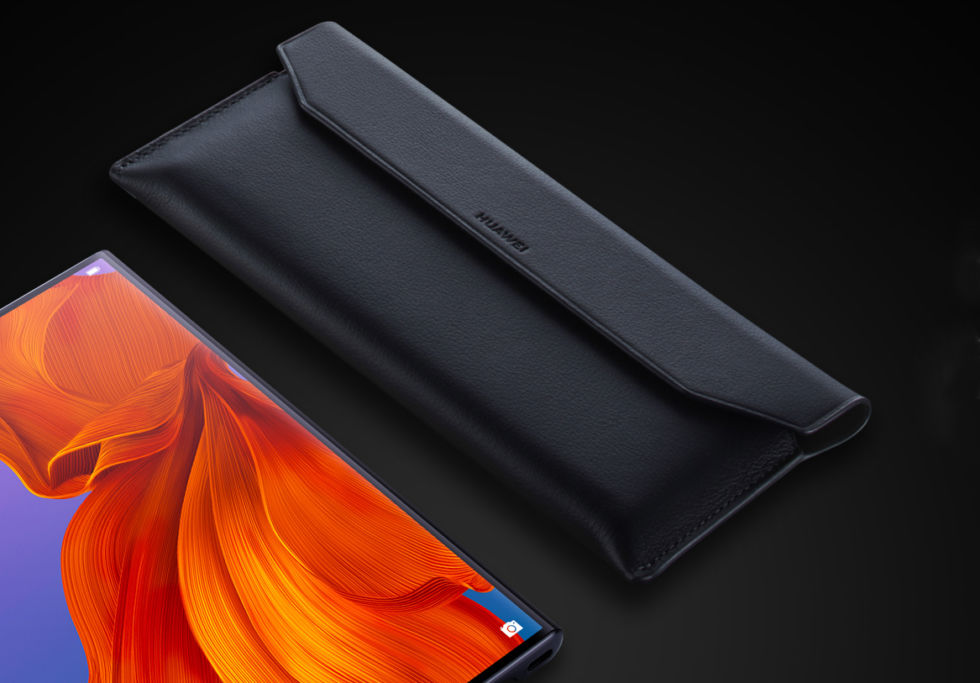-
The Huawei Mate X uses one big wraparound display made by BOE.Huawei
-
You get a huge 8-inch display when open and a 6.6-inch display when closed.Huawei
-
The back has a 6.38-inch display, along with this component bar for cameras, buttons, and ports.Huawei
-
The three cameras on the bar pull double-duty for selfies and regular photos.Huawei
-
Huawei's patented hinge tries to flatten out the screen by expanding when it opens.Huawei
-
When opened up, you get a huge 8-inch Android tablet.Huawei
-
There's a fingerprint reader on the side.Huawei
-
There are batteries in both halves of the device, for a total of 4500mAh.Huawei
-
Here's a fun look at the inside of the device. The 5G components are highlighted.Huawei
-
Get ready to use some Android tablet apps.Huawei
Huawei's futuristic foldable smartphone, the Huawei Mate X, is finally a real product. The phone went on sale in China today for the heart-stopping price of $2,421 (16,999 yuan).
Just like that other foldable smartphone on the market, the Galaxy Fold, the Mate X had a very bumpy road on its way to market full of delays and setbacks. The phone was originally scheduled for release in "the middle of the year," but in the midst of the US' Huawei export ban and the Galaxy Fold's initial delay, Huawei opted to delay the Mate X. The new launch target was September, but when September rolled around, the phone was delayed again to today's November 15 launch date.
Not much has changed since the initial announcement. Wrapped around the body of the Mate X is a flexible OLED display made by BOE. The panel is an 8-inch 2480×2200 tablet when open. When closed, it splits into a 2480×1148, 6.6-inch display on the front and a 6.3-inch, 2480×892 display on the back. The back is a bit smaller because it also houses the component bar, which is the one section of the phone that doesn't split in half. This thicker section houses important components like the three cameras, a power button, a fingerprint reader, and a USB-C port on the bottom.
The internals are a Huawei Kirin 980 SoC, 8GB of RAM, 512GB of storage, and a huge 4500mAh battery. 5G support is mandatory in this phone, thanks to the "Balong 5000" modem included in all models. Keep in mind this is only for China's (and the rest of the world's) "mid-band" 5G, not the US' "mmWave" 5G. They are two totally different technologies on different chunks of the spectrum.
The Huawei Mate X is a unique design even within the emerging foldables market so far. Unlike the Galaxy Fold, which puts the foldable display on the inside of the device and opens up like a book, the Mate X wraps the display around the outside of the device. The Mate X design has a few advantages: it can be a phone when folded up and a tablet when unfolded, and it does this all with a single screen, unlike the two screens (inside and outside) that are on the Galaxy Fold. By wrapping the display around the outside of the phone body, the Mate X doesn't put a hard crease in the display, like the Galaxy Fold does. A single camera can act as both the "front" selfie camera and "rear" main camera, just by flipping the phone around.
The major downside to this design is that, for now, the only flexible display cover on the market is a delicate soft plastic. The plastic display covers are easy to scratch, dent, and permanently damage. The Galaxy Fold protects the soft display by putting it on the inside of the phone, so when it's closed, it's not exposed to the world. With the display on the outside, the soft, delicate plastic is going to be constantly grinding against whatever's on the table, or whatever's in your pocket, so the durability of the Mate X is a serious concern. Huawei seems to have a solution, though.

This a protective leather handbag that seems to ship with the phone. It's an envelope style design, and you can't use the phone at all when it's in the case. It's unclear when exactly you're expected to use this. Taking the phone in and out of the case every time you use it would be incredibly cumbersome. Does it come with a belt loop like an old-school Blackberry? Many people use protective cases on their smartphones like a rubber bumper, which allows you to use the phone while having a protective ring of rubber along the outside. It's hard to imagine a case in that style that would protect the Mate X design while it's in use.
Someday, it sounds like we're going to have flexible glass for these foldable devices, and then a design like this will be a lot more feasible. Corning is working on a foldable version of Gorilla Glass, and Samsung has teamed up with a fellow Korean company called "Dowoo Insys" to make an "ultra-thin glass" that will be used in future Samsung foldables. For now, however, we only have scratchable plastic, and the Mate X seems ahead of its time.It's not clear if the Mate X will ever leave China. Any foldable at this point is going to be a very expensive, borderline experimental device with limited appeal. For Huawei specifically, it is still dealing with the fallout from the US export ban. The last phone it launched in Europe, the Mate 30 Pro, didn't come with Google apps.
reader comments
79